Frank Neese (Max Planck) and Serena DeBeer (Cornell University), predict iron K-edge XAS pre-edge features for iron complexes using time-dependent density functional theory in this Dalton Transactions Hot article.
and Serena DeBeer (Cornell University), predict iron K-edge XAS pre-edge features for iron complexes using time-dependent density functional theory in this Dalton Transactions Hot article.
This work is building on the teams earlier investigations into ferrous and ferric complexes. The group will use their improved understanding of high valent iron intermediates to explain more about the behaviour of metalloproteins, and in this case they look at the heme active site of P450.
This paper is part of a themed issue guest edited by Stuart MacGregor (Heriot-Watt) on Computational Chemistry of Molecular Inorganic Systems that will be published online in the next few weeks. Make sure you hear about it by signing up to the Dalton Transactions table of contents e-alerts.
Read the full article for FREE until 8th November to find out more about the use of X-ray absorption spectroscopy to understand metalloproteins…
Prediction of high-valent iron K-edge absorption spectra by time-dependent Density Functional Theory
P. Chandrasekaran, S. Chantal E. Stieber, Terrence J. Collins, Lawrence Que, Jr., Frank Neese and Serena DeBeer
Dalton Trans., 2011, DOI: 10.1039/C1DT11331C
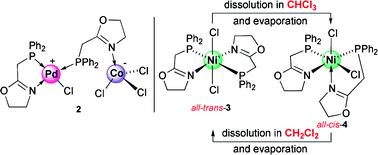











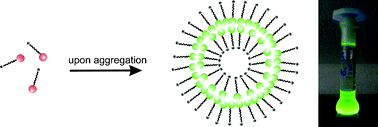
 Braunstein and co-workers have formed a dinuclear Ir(I) complex with a bis-NHC ligand in situ from
Braunstein and co-workers have formed a dinuclear Ir(I) complex with a bis-NHC ligand in situ from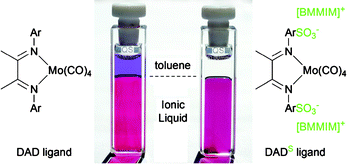 Oelkers and Sundermeyer, in this HOT Article, present a general approach towards 1,4-diazabutadiene (DADS) ligands with various onium cations via acid–base reactions and towards their noble-metal complexes. The solubility and immobilization of such complexes in ILs is quantitatively shown via photometric measurements using a chromophoric Mo(0) DADS complex in a toluene/[BMIM]OTf biphasic mixture as a model system. It was shown that complexes with ionic liquid (IL) – typical onium salts of sulfonated diazadienes as ligands are strongly retained in an IL phase in contact with a toluene phase, which may make these ligands potentially useful in IL/organic biphasic catalysis.
Oelkers and Sundermeyer, in this HOT Article, present a general approach towards 1,4-diazabutadiene (DADS) ligands with various onium cations via acid–base reactions and towards their noble-metal complexes. The solubility and immobilization of such complexes in ILs is quantitatively shown via photometric measurements using a chromophoric Mo(0) DADS complex in a toluene/[BMIM]OTf biphasic mixture as a model system. It was shown that complexes with ionic liquid (IL) – typical onium salts of sulfonated diazadienes as ligands are strongly retained in an IL phase in contact with a toluene phase, which may make these ligands potentially useful in IL/organic biphasic catalysis.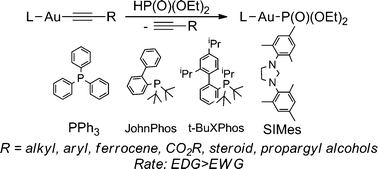 In this HOT Article, US researchers have presented an in depth reactivity study of alkynylgold species and phosphonates. As protodeauration is the main terminating step in gold catalysis, the effect of labile P–H bonds will be of interest to those studying gold catalysis, as well as those studying phosphite chemistry.
In this HOT Article, US researchers have presented an in depth reactivity study of alkynylgold species and phosphonates. As protodeauration is the main terminating step in gold catalysis, the effect of labile P–H bonds will be of interest to those studying gold catalysis, as well as those studying phosphite chemistry.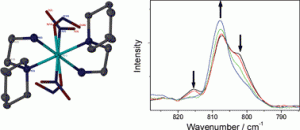

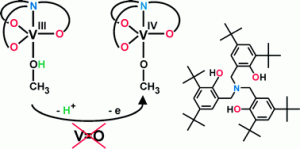
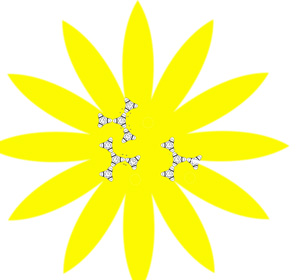

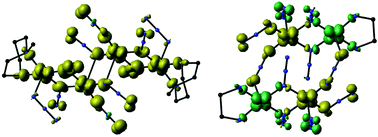 This HOT article by Mukherjee et al. reports the synthesis, structure, magnetic properties and DFT studies of four Cu(II)-azide polymers. Cu(II)-azide polymers are presently being studied by many groups due to their interesting structural variation and magnetic properties. In this paper, three out of the four compounds studied are of new structural topologies. All four complexes exhibit an overall ferromagnetic behaviour; the magnetic results are corroborated by DFT studies. The structural analysis shows how a simple change in the structure of the blocking ligand can generate entirely different structures and magnetic properties, even though the basic structures seems to be almost identical. It is also shown that another blocking diamine does not produce similar complexes under the same reaction conditions, which leads to the question: are certain compositions forbidden?
This HOT article by Mukherjee et al. reports the synthesis, structure, magnetic properties and DFT studies of four Cu(II)-azide polymers. Cu(II)-azide polymers are presently being studied by many groups due to their interesting structural variation and magnetic properties. In this paper, three out of the four compounds studied are of new structural topologies. All four complexes exhibit an overall ferromagnetic behaviour; the magnetic results are corroborated by DFT studies. The structural analysis shows how a simple change in the structure of the blocking ligand can generate entirely different structures and magnetic properties, even though the basic structures seems to be almost identical. It is also shown that another blocking diamine does not produce similar complexes under the same reaction conditions, which leads to the question: are certain compositions forbidden? and Serena DeBeer (Cornell University), predict iron K-edge XAS pre-edge features for iron complexes using time-dependent density functional theory in this Dalton Transactions Hot article.
and Serena DeBeer (Cornell University), predict iron K-edge XAS pre-edge features for iron complexes using time-dependent density functional theory in this Dalton Transactions Hot article.